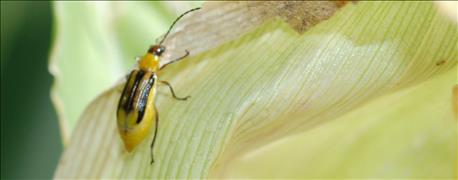May 27, 2016

Sticky traps can help farmers define the level of corn rootworm pressure in their fields and then make informed management decisions to mitigate the impact of this pest.
Sticky traps provide a snapshot of adult populations in the fields this season. Adults will lay eggs in July and August that will hatch next year into the larvae that will feed on and damage corn. Pioneer has ordered thousands of low-cost sticky traps for the upcoming season’s monitoring in the Dakotas, and will work with area growers to develop protocols for corn-rootworm management based on results.

A Western Corn Rootworm adult crawls on a corn leaf. Sticky traps can catch them so you can determine the population level.
In addition to sticky traps, digging corn roots in late July can help monitor corn-rootworm activity. Even if corn-rootworm pressure has been low in a particular field in recent years, the pest can resurge if winter and spring conditions favor a high survival of eggs and larvae.
How to use sticky traps
Effective surveying with sticky traps requires six traps in each field. Place the traps at least 100 feet from the edge of the field during the third or fourth week of July.
Once traps are in place, count the number of beetles per trap once per week. Counts exceeding 50 beetles per trap over seven days indicate a definite threat of corn rootworm pressure for the 2017 season. If counts average less than 50 beetles per trap, place new traps in the field and continue for another seven days.
Continue this weekly monitoring for a total of four weeks, or until the traps average more than 50 beetles per trap. However, if trap counts are still increasing during the last week of monitoring, it is a good idea to trap for an additional two weeks, or until more than 50 beetles per trap have been captured.
Treatment thresholds
If traps average less than 21 beetles per trap, per week, low rootworm populations are anticipated for the following year. Economic damage from corn rootworm can still occur in dry growing conditions, but with low pressure, the need to treat is minimal.
If traps average 21 to 50 beetles per trap, per week, moderate rootworm populations can be anticipated for the following year. Consider the following corn-rootworm-control options:
* Plant a corn rootworm Bt corn product.
* Control larvae with a soil-applied insecticide at planting.
* Apply foliar insecticide to control adult beetles during late summer, prior to egg laying.
* Rotate to another crop.
If there are 50 beetles or more per trap, per week, high rootworm populations can be anticipated for the following year. Consider the following options:
* Rotate to another crop. This is the best option in areas where western or northern rootworm variants are not a concern and brings with it additional crop-management benefits.
* If rotation is not an option, use foliar insecticide to control adult beetles prior to egg laying, and follow with a corn rootworm Bt hybrid or soil-applied insecticide next season.
*Plant a single-trait corn rootworm Bt corn hybrid and consider adding a soil-applied insecticide, or use a pyramided rootworm-protection Bt product.
Remember, using the same mode of action for control year after year leads to risks that insects will develop resistance to that mode of action. Ideally, no field should use the same trait for three or more consecutive years.
Kayser, Emery, S.D., is a DuPont Pioneer agronomist.
You May Also Like




